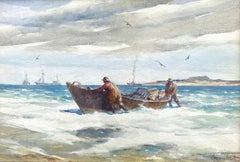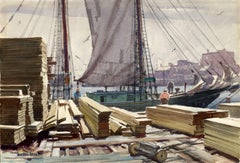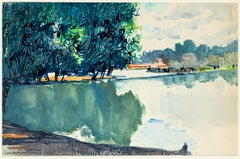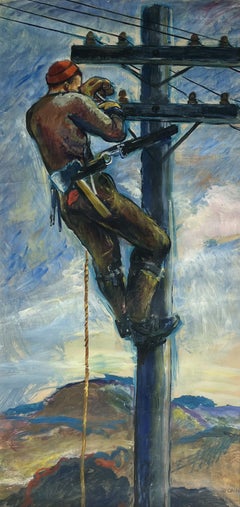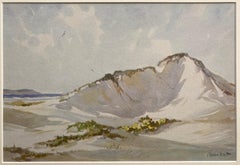Gordon Grant Landscape Drawings and Watercolors
American, 1875-1962
Born in San Francisco, Gordon Grant is known for his etchings and paintings of marine subjects. He also painted portraits, streets, harbors, beaches and marines, and was an illustrator, whose work included pulp fiction* for Popular Detective magazine in the 1930s. Skilled with watercolor, Grant was honored many times by the American Watercolor Society*. Memberships included the Society of Illustrators*, Salmagundi Club*, Allied Artists of America*, New York Society of Painters, and American Federation of Artists*.
At age 13, he was sent to Scotland for schooling, and the four-month sail around Cape Horn remained a permanent influence on his career. He studied art in Heatherly and at the Lambeth School of Art* in London, and then in 1895, he became a staff artist for the San Francisco Examiner. The next year, he took the same type of job for the New York World and covered the Boer War for Harper's Weekly.to
1
1
Overall Width
to
Overall Height
to
2
1
1
2
2
2
1
1
1
1
2
2
1
1
1
11
143
125
66
60
1
1
2
Artist: Gordon Grant
“The Lobstermen”
By Gordon Grant
Located in Southampton, NY
Beautiful original watercolor and gouache on archival paper by the famous American marine artist, Gordon Grant. The artwork depicts two rugged lobstermen bringing their catch ashore...
Category
1930s American Realist Gordon Grant Landscape Drawings and Watercolors
Materials
Watercolor, Gouache, Archival Paper
The Lumber Wharf
By Gordon Grant
Located in New York, NY
Gordon Hope Grant (1875-1962) created the watercolor entitled “The Lumber Wharf” in circa 1947. It is signed in the lower left 1 inch above the paper edge. The watercolor paper size ...
Category
1940s Naturalistic Gordon Grant Landscape Drawings and Watercolors
Materials
Watercolor
Related Items
Landscape - Marker and Watercolor by E. Pavarino - 1969
By Ermanno Pavarino
Located in Roma, IT
Landscape is an original drawing in China ink and watercolor on paper, realized by Ermanno Pavarino in 1969.
The state of preservation of the artwork is very good.
Hand-signed and d...
Category
1960s Gordon Grant Landscape Drawings and Watercolors
Materials
Watercolor, Permanent Marker
$311
H 12.8 in W 19.49 in D 0.08 in
Man Working Mid 20th Century American Scene Social Realism Industrial WPA Modern
By Jo Cain
Located in New York, NY
Man Working Mid 20th Century American Scene Social Realism Industrial WPA Modern
Jo Cain (1904 - 2003)
Telephone Pole Worker
38 1/4 x 18 1/2 inches
Oil on pap...
Category
1930s American Realist Gordon Grant Landscape Drawings and Watercolors
Materials
Paper, Gouache
$5,000
H 48 in W 28 in D 2 in
Architectural Design Original Ink and Watercolor on Cardboard-Early 20th Century
Located in Roma, IT
Architectural design is an original painting in ink and watercolor on cardboard by Anonymous french Artist in the early 20th Century.
Good conditions except for being aged and repai...
Category
Early 20th Century Modern Gordon Grant Landscape Drawings and Watercolors
Materials
Ink, Watercolor
Architectural Design Original Ink and Watercolor on Cardboard-Early 20th Century, Early 20th Century
$814
H 15.36 in W 35.04 in D 0.04 in
Whimsical Illustration Skiing Cartoon, 1938 Mt Tremblant Ski Lodge William Steig
By William Steig (b.1907)
Located in Surfside, FL
Lighthearted Illustration of Outdoor Pursuits This one being a Skiing scene, a boy and a girl on skis. signed W. Steig
Provenance: from Mrs. Joseph B. Ryan, Commissioned by Joe Ryan for the bar at his ski resort, Mount Tremblant Lodge, in 1938.
Mont Tremblant, P.Q., Canada
Watercolor and ink on illustration board, sights sizes 8 1/2 x 16 1/2 in., framed.
In 1938 Joe Ryan, described as a millionaire from Philadelphia, bushwhacked his way to the summit of Mont Tremblant and was inspired to create a world class ski resort at the site. In 1939 he opened the Mont Tremblant Lodge, which remains part of the Pedestrian Village today. This original illustration is on Whatman Illustration board. the board measures 14 X 22 inches. label from McClees Galleries, Philadelphia, on the frame backing paper.
William Steig, 1907 – 2003 was an American cartoonist, sculptor, and, in his later life, an illustrator and writer of children's books. Best known for the picture books Sylvester and the Magic Pebble, Abel's Island, and Doctor De Soto, he was also the creator of Shrek!, which inspired the film series of the same name. He was the U.S. nominee for both of the biennial, international Hans Christian Andersen Awards, as a children's book illustrator in 1982 and a writer in 1988.
Steig was born in Brooklyn, New York in 1907, and grew up in the Bronx. His parents were Polish-Jewish immigrants from Austria, both socialists. His father, Joseph Steig, was a house painter, and his mother, Laura Ebel Steig, was a seamstress who encouraged his artistic leanings. As a child, he dabbled in painting and was an avid reader of literature. Among other works, he was said to have been especially fascinated by Pinocchio.He graduated from Townsend Harris High School at 15 but never completed college, though he attended three, spending two years at City College of New York, three years at the National Academy of Design and a mere five days at the Yale School of Fine Arts before dropping out of each.
Hailed as the "King of Cartoons" Steig began drawing illustrations and cartoons for The New Yorker in 1930, producing more than 2,600 drawings and 117 covers for the magazine. Steig, later, when he was 61, began writing children's books. In 1968, he wrote his first children's book. He excelled here as well, and his third book, Sylvester and the Magic Pebble (1969), won the Caldecott Medal. He went on to write more than 30 children's books, including the Doctor DeSoto series, and he continued to write into his nineties. Among his other well-known works, the picture book Shrek! (1990) formed the basis for the DreamWorks Animation film Shrek (2001). After the release of Shrek 2 in 2004, Steig became the first sole-creator of an animated movie franchise that went on to generate over $1 billion from theatrical and ancillary markets after only one sequel. Along with Maurice Sendak, Saul Steinberg, Ludwig Bemelmans and Laurent de Brunhofff his is one of those rare cartoonist whose works form part of our collective cultural heritage.
In 1984, Steig's film adaptation of Doctor DeSoto directed by Michael Sporn was nominated for the Academy Award for Best Animated Short Film. As one of the most admired cartoonists of all time, Steig spent seven decades drawing for the New Yorker magazine. He touched generations of readers with his tongue–in–cheek pen–and–ink drawings, which often expressed states of mind like shame, embarrassment or anger. Later in life, Steig turned to children's books, working as both a writer and illustrator.
Steig's children's books were also wildly popular because of the crazy, complicated language he used—words like lunatic, palsied, sequestration, and cleave. Kids love the sound of those words even if they do not quite understand the meaning. Steig's descriptions were also clever. He once described a beached whale as "breaded with sand."
Throughout the course of his career, Steig compiled his cartoons and drawings into books. Some of them were published first in the New Yorker. Others were deemed too dark to be printed there. Most of these collections centered on the cold, dark psychoanalytical truth about relationships. They featured husbands and wives fighting and parents snapping at their kids. His first adult book, Man About Town, was published in 1932, followed by About People, published in 1939, which focused on social outsiders. Sick of Each Other, published in 2000, included a drawing depicting a wife holding her husband at gunpoint, saying, "Say you adore me."
According to the Los Angeles Times, fellow New Yorker artist Edward Sorel...
Category
1930s Naturalistic Gordon Grant Landscape Drawings and Watercolors
Materials
Archival Ink, Watercolor, Illustration Board
Farm at Stover Mill, Bucks County, Pennsylvania, Regional American Landscape
Located in Doylestown, PA
Stover Mill is an American regional landscape of a historic mill and farm in Bucks County, Pennsylvania by local resident and artist Loraine Thompson. The 10.5 x 13.5 inches watercol...
Category
Early 2000s American Realist Gordon Grant Landscape Drawings and Watercolors
Materials
Watercolor, Archival Paper
$500
H 17 in W 21 in D 1 in
Industrial Man Working Mid 20th Century American Scene Social Realism Modern WPA
By Jo Cain
Located in New York, NY
Industrial Man Working Mid 20th Century American Scene Social Realism Modern WPA
Jo Cain (1904 - 2003)
Hammering Nails
39 x 50 ½ inches
Gouache on paper c. 19...
Category
1930s American Realist Gordon Grant Landscape Drawings and Watercolors
Materials
Paper, Gouache
$18,000
H 44 in W 32 in D 2 in
Whimsical Illustration Hiking Cartoon, 1938 Mt Tremblant Ski Lodge William Steig
By William Steig (b.1907)
Located in Surfside, FL
Lighthearted Illustration of Outdoor Pursuits This one being cross country hiking signed "W. Steig"
Provenance: from Mrs. Joseph B. Ryan, Commissioned by Joe Ryan for the bar at his ski resort, Mount Tremblant Lodge, in 1938.
Mont Tremblant, P.Q., Canada
Watercolor and ink on illustration board, sights sizes 8 1/2 x 16 1/2 in., framed.
In 1938 Joe Ryan, described as a millionaire from Philadelphia, bushwhacked his way to the summit of Mont Tremblant and was inspired to create a world class ski resort at the site. In 1939 he opened the Mont Tremblant Lodge, which remains part of the Pedestrian Village today. This original illustration is on Whatman Illustration board. the board measures 14 X 22 inches. label from McClees Galleries, Philadelphia, on the frame backing paper.
William Steig, 1907 – 2003 was an American cartoonist, sculptor, and, in his later life, an illustrator and writer of children's books. Best known for the picture books Sylvester and the Magic Pebble, Abel's Island, and Doctor De Soto, he was also the creator of Shrek!, which inspired the film series of the same name. He was the U.S. nominee for both of the biennial, international Hans Christian Andersen Awards, as a children's book illustrator in 1982 and a writer in 1988.
Steig was born in Brooklyn, New York in 1907, and grew up in the Bronx. His parents were Polish-Jewish immigrants from Austria, both socialists. His father, Joseph Steig, was a house painter, and his mother, Laura Ebel Steig, was a seamstress who encouraged his artistic leanings. As a child, he dabbled in painting and was an avid reader of literature. Among other works, he was said to have been especially fascinated by Pinocchio.He graduated from Townsend Harris High School at 15 but never completed college, though he attended three, spending two years at City College of New York, three years at the National Academy of Design and a mere five days at the Yale School of Fine Arts before dropping out of each.
Hailed as the "King of Cartoons" Steig began drawing illustrations and cartoons for The New Yorker in 1930, producing more than 2,600 drawings and 117 covers for the magazine. Steig, later, when he was 61, began writing children's books. In 1968, he wrote his first children's book. He excelled here as well, and his third book, Sylvester and the Magic Pebble (1969), won the Caldecott Medal. He went on to write more than 30 children's books, including the Doctor DeSoto series, and he continued to write into his nineties. Among his other well-known works, the picture book Shrek! (1990) formed the basis for the DreamWorks Animation film Shrek (2001). After the release of Shrek 2 in 2004, Steig became the first sole-creator of an animated movie franchise that went on to generate over $1 billion from theatrical and ancillary markets after only one sequel. Along with Maurice Sendak, Saul Steinberg, Ludwig Bemelmans and Laurent de Brunhofff his is one of those rare cartoonist whose works form part of our collective cultural heritage.
In 1984, Steig's film adaptation of Doctor DeSoto directed by Michael Sporn was nominated for the Academy Award for Best Animated Short Film. As one of the most admired cartoonists of all time, Steig spent seven decades drawing for the New Yorker magazine. He touched generations of readers with his tongue–in–cheek pen–and–ink drawings, which often expressed states of mind like shame, embarrassment or anger. Later in life, Steig turned to children's books, working as both a writer and illustrator.
Steig's children's books were also wildly popular because of the crazy, complicated language he used—words like lunatic, palsied, sequestration, and cleave. Kids love the sound of those words even if they do not quite understand the meaning. Steig's descriptions were also clever. He once described a beached whale as "breaded with sand."
Throughout the course of his career, Steig compiled his cartoons and drawings into books. Some of them were published first in the New Yorker. Others were deemed too dark to be printed there. Most of these collections centered on the cold, dark psychoanalytical truth about relationships. They featured husbands and wives fighting and parents snapping at their kids. His first adult book, Man About Town, was published in 1932, followed by About People, published in 1939, which focused on social outsiders. Sick of Each Other, published in 2000, included a drawing depicting a wife holding her husband at gunpoint, saying, "Say you adore me."
According to the Los Angeles Times, fellow New Yorker artist Edward Sorel...
Category
1930s Naturalistic Gordon Grant Landscape Drawings and Watercolors
Materials
Archival Ink, Watercolor, Illustration Board
Norwegian Pine Grove - The inner glow of the trees -
Located in Berlin, DE
Themistokles von Eckenbrecher (1842 Athens - 1921 Goslar), Norwegian pine grove, 1901. Watercolor on blue-green paper, 30 x 22 cm. Signed, dated and inscribed in his own hand "TvE. Fagermes [i.e. Fagermes]. 26.6.[19]01."
- Slight crease throughout at left margin, otherwise in good condition.
About the artwork
Themistokles von Eckenbrecher often traveled to Norway to study the nature that fascinated him there. On June 26, 1901, near the southern Norwegian town of Fagernes, in the summer evening sun, he saw a small pine grove, which he immediately captured in a watercolor. He exposed the trees growing on a small hill in front of the background, so that the pines completely define the picture and combine to form a tense motif. The tension comes from the contrast of form and color. The trunks, growing upward, form a vertical structure that is horizontally penetrated by the spreading branches and the pine needles, which are rendered as a plane. This structural tension is further intensified by the color contrast between the brown-reddish iridescent trunks and branches and the green-toned needlework.
Themistokles von Eckenbrecher, however, does not use the observed natural scene as an inspiring model for a dance of color and form that detaches itself from the motif and thus treads the path of abstracting modernism. Its inner vitality is to be brought to light and made aesthetically accessible through the work of art.
It is precisely in order to depict the inner vitality of nature that von Eckenbrecher chooses the technique of watercolor, in which the individual details, such as the needles, are not meticulously worked out, but rather a flowing movement is created that unites the contrasts. The trees seem to have formed the twisted trunks out of their own inner strength as they grew, creatingthose tense lineations that the artist has put into the picture. The inner strength continues in the branches and twigs, culminating in the upward growth of the needles. At the same time, the trunks, illuminated by the setting sun, seem to glow from within, adding an almost dramatic dimension to the growing movement.
Through the artwork, nature itself is revealed as art. In order to make nature visible as art in the work, von Eckenbrecher exposes the group of trees so that they are bounded from the outside by an all-encompassing contour line and merge into an areal unity that enters into a figure-ground relationship with the blue-greenish watercolor paper. The figure-ground relationship emphasizes the ornamental quality of the natural work of art, which further enforces the artwork character of the group of trees.
With the presentation of Themistokles von Eckenbrecher's artistic idea and its realization, it has become clear that the present watercolor is not a study of nature in the sense of a visual note by the artist, which might then be integrated into a larger work context, but a completely independent work of art. This is why von Eckenbrecher signed the watercolor. In addition, it is marked with a place and a date, which confirms that this work of nature presented itself to him in exactly this way at this place at this time. At the same time, the date and place make it clear that the natural work of art has been transferred into the sphere of art and thus removed from the time of the place of nature.
About the artist
Themistocles' parents instilled a life of travel in their son, who is said to have spoken eleven languages. His father, who was interested in ancient and oriental culture, was a doctor and had married Francesca Magdalena Danelon, an Italian, daughter of the British consul in Trieste. During a stay in Athens - Gustav von Eckenbrecher was a friend of Heinrich von Schliemann and is said to have given him crucial clues as to the location of Troy - Themistokles saw the light of day in 1842.
After an interlude in Berlin, where Themistokles was educated at the English-American School, the journey began again. From 1850 to 1857 the family lived in Constantinople, after which the father opened a practice in Potsdam, where Themistokles, who wanted to become a painter, was taught by the court painter Carl Gustav Wegener.
In 1861 the von Eckenbrechers left Potsdam and settled in Düsseldorf. There Themistokles received two years of private tuition from Oswald Aschenbach, who greatly admired the talented young artist. After his artistic training, he undertook extensive travels, often accompanied by Prince Peter zu Sayn-Wittgenstein, which took him to northern and eastern Europe, but above all to the Middle East and even to South America. The paintings that resulted from these journeys established his artistic reputation and led to his participation in large panoramas such as the 118 x 15 metre Entry of the Mecca Caravan into Cairo, painted for the City of Hamburg in 1882.
1882 was also the start of a total of 21 study trips to Scandinavia, most of them to Norway, and the unique Norwegian landscape with its rugged fjords became a central motif in his work. Along with Anders Askevold and Adelsteen Normann...
Category
Early 1900s Naturalistic Gordon Grant Landscape Drawings and Watercolors
Materials
Watercolor
$1,150 Sale Price
20% Off
H 11.82 in W 8.67 in
View Of Rome - Watercolor on Paper by C.R. Cockerell - Mid 19th Century
By Charles Robert Cockerell
Located in Roma, IT
View Of Rome is a beautiful artwork realized by Charles Robert Cockerell in the XIX century.
Watercolor on paper. Inscribed in pencil on lower left and verso.
This charming artwork...
Category
Mid-19th Century Modern Gordon Grant Landscape Drawings and Watercolors
Materials
Watercolor
$1,557
H 10.44 in W 10.63 in D 0.08 in
Thomaston Maine, Original Rooftop View Townscape in Watercolor
Located in Doylestown, PA
"Thomaston, Maine" is a 15 x 13.5 inches, watercolor townscape, signed in the lower left, and framed behind glass.
Ranulph Bye was born in 1916 in Princet...
Category
20th Century American Realist Gordon Grant Landscape Drawings and Watercolors
Materials
Watercolor, Archival Paper
$950
H 25.5 in W 24 in D 1 in
Seaward
Located in Burlingame, CA
'Seaward', depicting a cargo ship exiting Golden Gate, passing Seal Rock, and entering the Pacific.Ocean, is a highly collectable original 10 x 16 inch watercolor painting by Interna...
Category
21st Century and Contemporary American Realist Gordon Grant Landscape Drawings and Watercolors
Materials
Watercolor, Archival Paper
William Kay Blacklock ARCA, Continental Farmhouse In Summer
Located in Cheltenham, GB
This charming early 20th-century watercolour by eminent British artist William Kay Blacklock ARCA (1872-1924) depicts an elderly lady carrying a basket and parasol before a farmhouse...
Category
1920s English School Gordon Grant Landscape Drawings and Watercolors
Materials
Watercolor, Paper
Previously Available Items
UNTITLED NEW ENGLAND COASTAL SCENE
By Gordon Grant
Located in Santa Monica, CA
GORDON GRANT (1875 – 1962)
UNTITLED NEW ENGLAND COASTAL SCENE. c.1940-50
Watercolor, Signed at lower right. 9 3/8 x 13 1/4 inches. Laid down on b...
Category
1940s American Realist Gordon Grant Landscape Drawings and Watercolors
Materials
Watercolor
“The Lobstermen”
By Gordon Grant
Located in Southampton, NY
Beautiful original watercolor and gouache on archival paper by the famous American marine artist, Gordon Grant. The artwork depicts two rugged lobstermen bringing their catch ashore...
Category
1930s American Realist Gordon Grant Landscape Drawings and Watercolors
Materials
Watercolor, Gouache, Archival Paper
"Full Sail"
By Gordon Grant
Located in Southampton, NY
Beautifully rendered watercolor of a sailing ship under full sail in good original condition. Very slight fading or toning. Signed lower right and recently...
Category
1930s Realist Gordon Grant Landscape Drawings and Watercolors
Materials
Paper, Watercolor
Gordon Grant landscape drawings and watercolors for sale on 1stDibs.
Find a wide variety of authentic Gordon Grant landscape drawings and watercolors available for sale on 1stDibs. You can also browse by medium to find art by Gordon Grant in paint, watercolor, paper and more. Not every interior allows for large Gordon Grant landscape drawings and watercolors, so small editions measuring 10 inches across are available. Customers who are interested in this artist might also find the work of Charles De Wolf Brownell, Louis Wolchonok, and Michael DeFrancesco. Gordon Grant landscape drawings and watercolors prices can differ depending upon medium, time period and other attributes. On 1stDibs, the price for these items starts at $1,800 and tops out at $5,750, while the average work can sell for $4,700.
